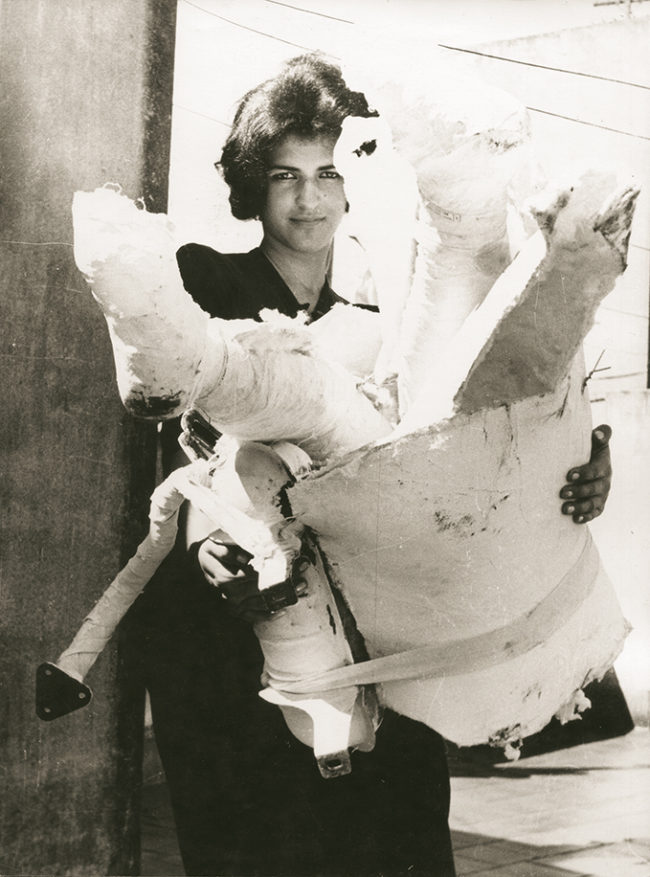

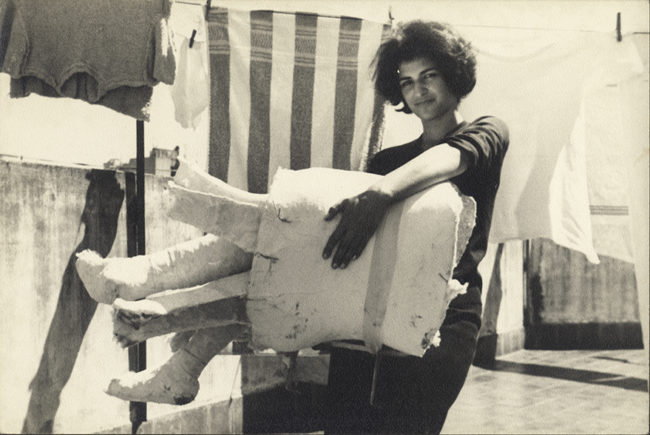

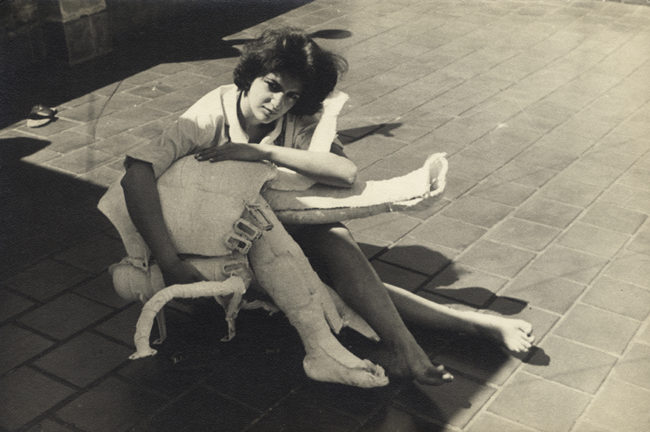

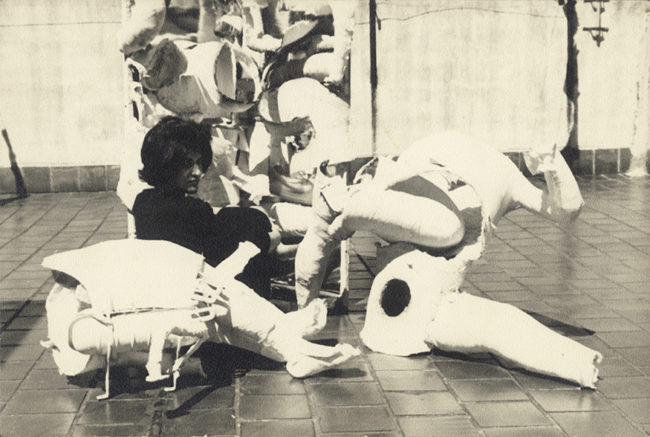

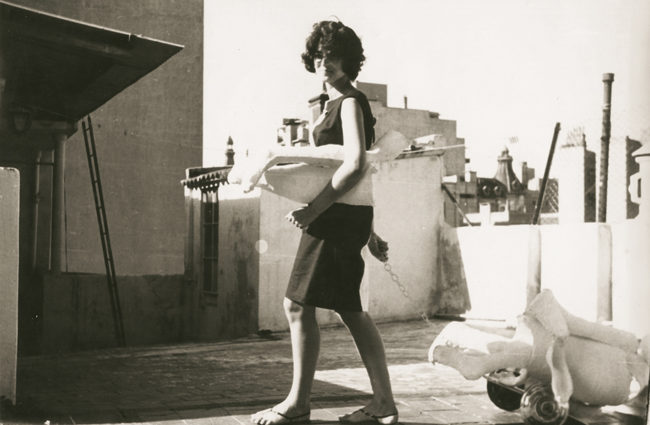

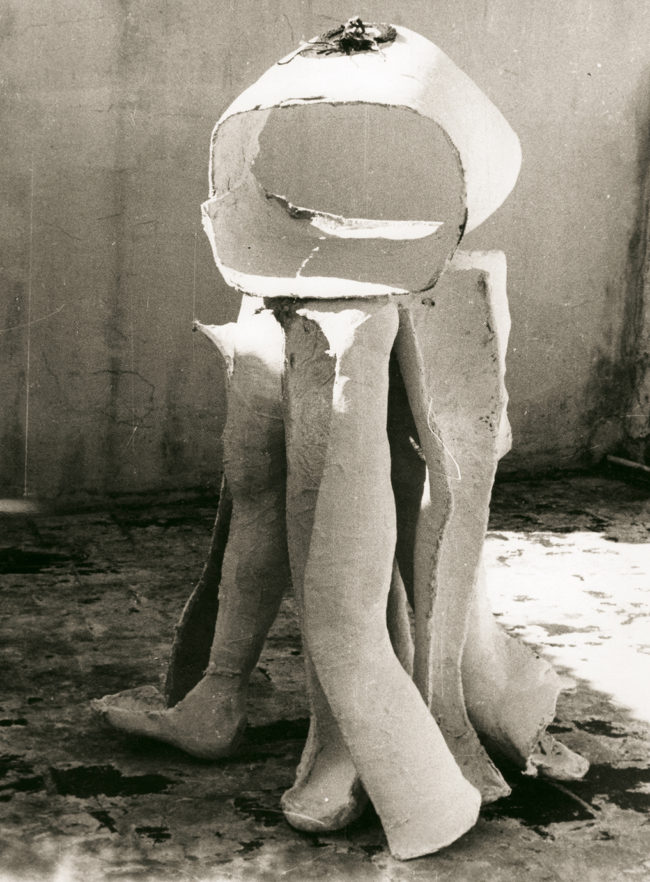

At Rafael Squirru’s conglomeration, in the first show that was dedicated to the objects, entitled ”El hombre antes del hombre” (”The man before the man”) (1962) was exhibited Dalila Puzzovio’s first plaster, Marta Minujín’s first mattress and one of Rubén Santantonín’s earliest works. Followed by this exhibition, in a critique text, Squirru writes: “What in United States has ended up being called ‘pop art’, and in Europe ‘the art of objects’, finds proponent in-between countries from Latin America with the name “art of things”. (…) The denomination ‘things’ or ‘art of things’ has a double charge of both objectivity and subjectivity. Things are outside ourselves, but we also claim that things happen to us, meaning that things are inside us too, this is the things that happen to us. Therefore, I find the denomination “art of the things” widely happy. (…) It is about of a kind of art about which we can say that the public is transformed into an objet d’art and they leave with it on themselves. (…) The attitude that gathers together the members of this iconoclastic promotion of visual endeavors (…) are, the way I see it, the mockery, the irreverence and the humor. It is a cosmic roaring laughter of which we are being forced to participate (…)”
Again, here he notes “the fierce grace of Delia Puzzovio’s plasters, extracted from Hospital Italiano, where she saw the possibility to give that tortured material an hedonist transcendency and constructed with them her strollers of ramshackled members or orthopedic legs on the shoe-polishing drawer.(…)”
Those plasters to whose he concerns were the central piece of one of his most remembered exhibitions entitled “Cáscaras” (1963), staged in the mythical and edgy gallery Lirolay. It was, actually, an installation where there were presented objects made of orthopedic plasters rescued from Hospital Italiano’s trash, amongst nurses that received the guests and asked them to be silent. This monument to pain, suggests a reflection about rupture and the broken orders; an improvement of the influences of Informalism, Pop-Art and Neo-Dadá, that marked her career, generating a genuine and bold gesture.
En la conglomeración de Rafael Squirru, en la primera muestra dedicada a objetos, titulada “El hombre antes del hombre”(1962) se exhibió el primer yeso de Dalila Puzzovio, el primer colchón de Marta Minujín y el primer atado de Rubén Santantonín. Seguido de esta exposición, en un texto de crítica Squirru escribe: ”Lo que en Estados Unidos ha dado en llamarse pop art y en Europa “el arte de los objetos”, encuentra cultores entre países de la América Latina con el nombre de “arte de las cosas”.(…) La denominación “cosas” o “arte de las cosas” lleva una doble carga de objetividad y de subjetividad. Las cosas están fuera de nosotros, pero también decimos que nos pasan cosas, o sea que las cosas están también dentro de nosotros, esto es, las cosas que nos pasan. Es por ello que encuentro la denominación “arte de las cosas” doblemente feliz.(…) Se trata de un arte del que podemos decir que el público se transforma en un objet d’art y el arte se lo lleva puesto.(…) La actitud que une a los integrantes de esta iconoclasta promoción del quehacer visual (…) son a mi entender la burla, la irreverencia y el humor. Se trata de una gran carcajada cósmica de la que estamos obligados a participar (…)”
Nuevamente aquí señala “la feroz gracia de los yesos de Delia Puzzovio extraídos del Hospital Italiano, donde vió la posibilidad a ese material torturado de darle una trascendencia hedonista y construyó con ellos sus cochecitos de miembros destartalados o las piernas ortopédicas sobre el cajón de lustrar botines.(…)”
Aquellos yesos a los que refiere fueron la obra central de una de sus exhibiciones más recordadas que se tituló Cáscaras (1963), montada en la mítica y vanguardista galería Lirolay. Fue en realidad una instalación, donde presentó objetos realizados con yesos ortopédicos rescatados de la basura del Hospital Italiano, entre recepcionistas con uniformes de enfermeras que recibían a los invitados y les pedían que hicieran silencio.Este monumento al dolor, sugiere una reflexión sobre la ruptura y los órdenes fracturados; una superación de las influencias del Informalismo, Pop-art y Neo-dadá, que marcaron su trayectoria, generando un gesto genuino y audaz.
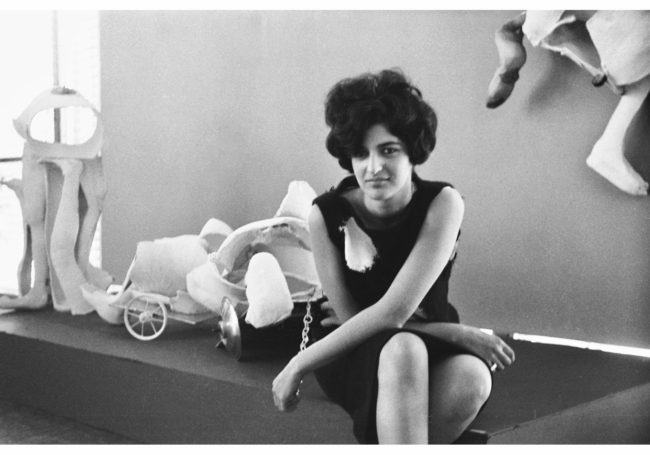

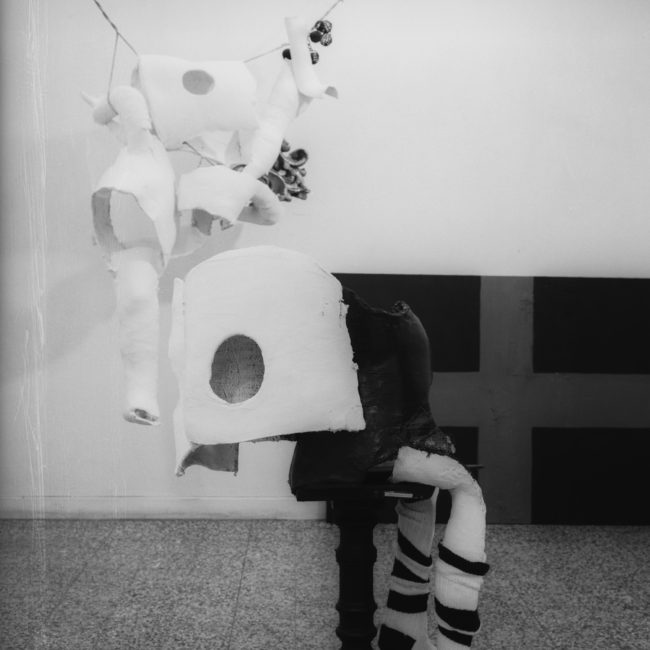

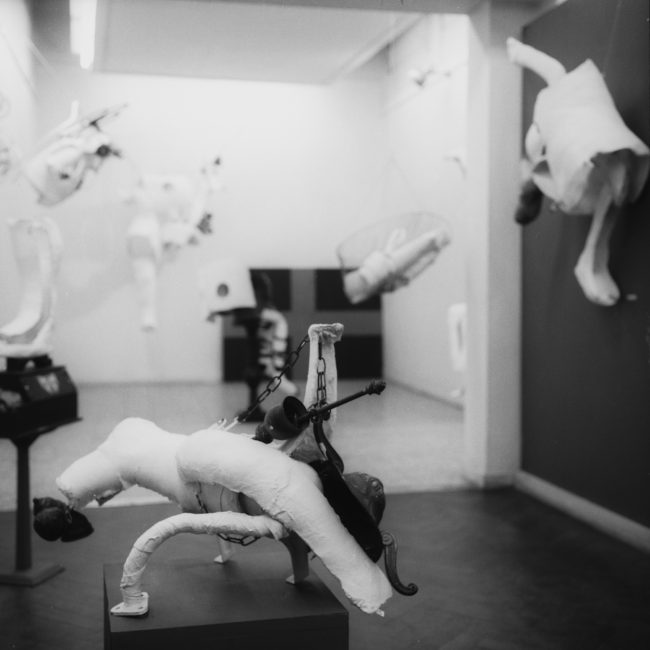

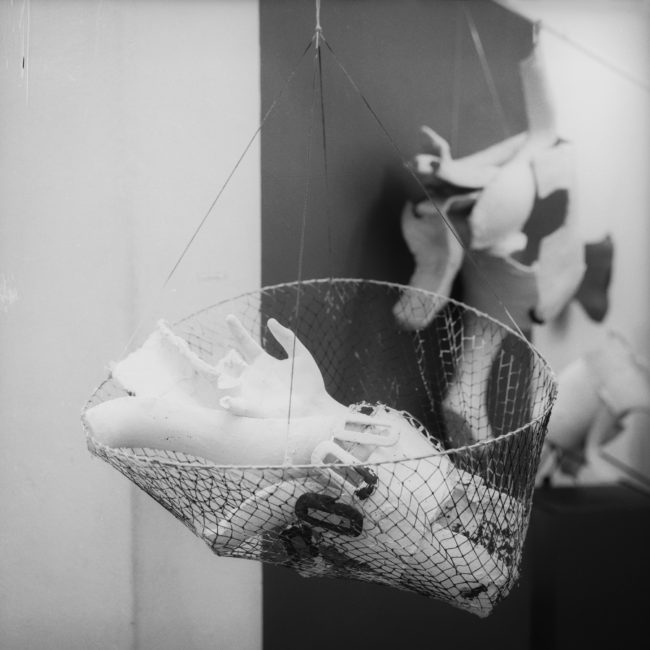

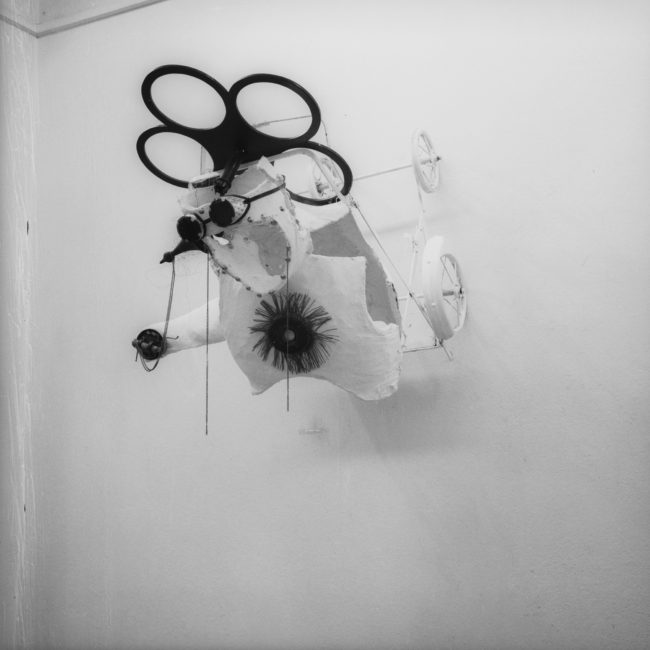

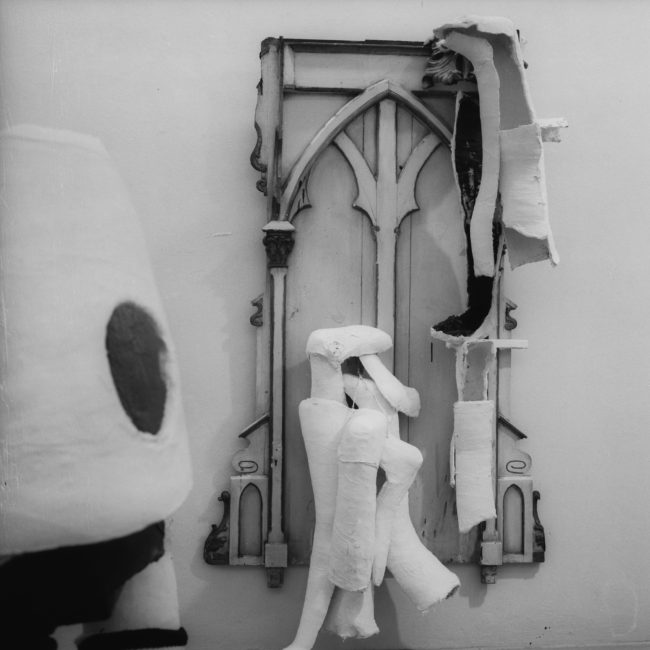



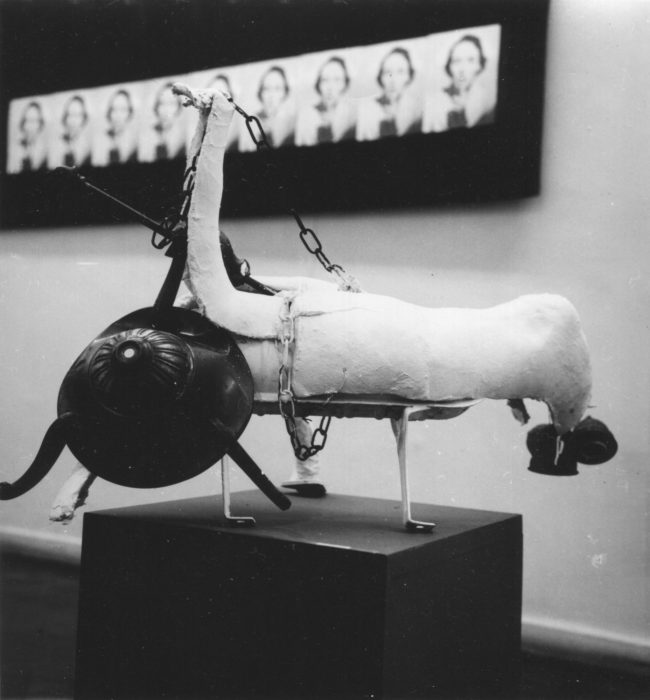





At Rafael Squirru’s conglomeration, in the first show that was dedicated to the objects, entitled ”El hombre antes del hombre” (”The man before the man”) (1962) was exhibited Dalila Puzzovio’s first plaster, Marta Minujín’s first mattress and one of Rubén Santantonín’s earliest works. Followed by this exhibition, in a critique text, Squirru writes: “What in United States has ended up being called ‘pop art’, and in Europe ‘the art of objects’, finds proponent in-between countries from Latin America with the name “art of things”. (…) The denomination ‘things’ or ‘art of things’ has a double charge of both objectivity and subjectivity. Things are outside ourselves, but we also claim that things happen to us, meaning that things are inside us too, this is the things that happen to us. Therefore, I find the denomination “art of the things” widely happy. (…) It is about of a kind of art about which we can say that the public is transformed into an objet d’art and they leave with it on themselves. (…) The attitude that gathers together the members of this iconoclastic promotion of visual endeavors (…) are, the way I see it, the mockery, the irreverence and the humor. It is a cosmic roaring laughter of which we are being forced to participate (…)”
Again, here he notes “the fierce grace of Delia Puzzovio’s plasters, extracted from Hospital Italiano, where she saw the possibility to give that tortured material an hedonist transcendency and constructed with them her strollers of ramshackled members or orthopedic legs on the shoe-polishing drawer.(…)”
Those plasters to whose he concerns were the central piece of one of his most remembered exhibitions entitled “Cáscaras” (1963), staged in the mythical and edgy gallery Lirolay. It was, actually, an installation where there were presented objects made of orthopedic plasters rescued from Hospital Italiano’s trash, amongst nurses that received the guests and asked them to be silent. This monument to pain, suggests a reflection about rupture and the broken orders; an improvement of the influences of Informalism, Pop-Art and Neo-Dadá, that marked her career, generating a genuine and bold gesture.
En la conglomeración de Rafael Squirru, en la primera muestra dedicada a objetos, titulada “El hombre antes del hombre”(1962) se exhibió el primer yeso de Dalila Puzzovio, el primer colchón de Marta Minujín y el primer atado de Rubén Santantonín. Seguido de esta exposición, en un texto de crítica Squirru escribe: ”Lo que en Estados Unidos ha dado en llamarse pop art y en Europa “el arte de los objetos”, encuentra cultores entre países de la América Latina con el nombre de “arte de las cosas”.(…) La denominación “cosas” o “arte de las cosas” lleva una doble carga de objetividad y de subjetividad. Las cosas están fuera de nosotros, pero también decimos que nos pasan cosas, o sea que las cosas están también dentro de nosotros, esto es, las cosas que nos pasan. Es por ello que encuentro la denominación “arte de las cosas” doblemente feliz.(…) Se trata de un arte del que podemos decir que el público se transforma en un objet d’art y el arte se lo lleva puesto.(…) La actitud que une a los integrantes de esta iconoclasta promoción del quehacer visual (…) son a mi entender la burla, la irreverencia y el humor. Se trata de una gran carcajada cósmica de la que estamos obligados a participar (…)”
Nuevamente aquí señala “la feroz gracia de los yesos de Delia Puzzovio extraídos del Hospital Italiano, donde vió la posibilidad a ese material torturado de darle una trascendencia hedonista y construyó con ellos sus cochecitos de miembros destartalados o las piernas ortopédicas sobre el cajón de lustrar botines.(…)”
Aquellos yesos a los que refiere fueron la obra central de una de sus exhibiciones más recordadas que se tituló Cáscaras (1963), montada en la mítica y vanguardista galería Lirolay. Fue en realidad una instalación, donde presentó objetos realizados con yesos ortopédicos rescatados de la basura del Hospital Italiano, entre recepcionistas con uniformes de enfermeras que recibían a los invitados y les pedían que hicieran silencio.Este monumento al dolor, sugiere una reflexión sobre la ruptura y los órdenes fracturados; una superación de las influencias del Informalismo, Pop-art y Neo-dadá, que marcaron su trayectoria, generando un gesto genuino y audaz.
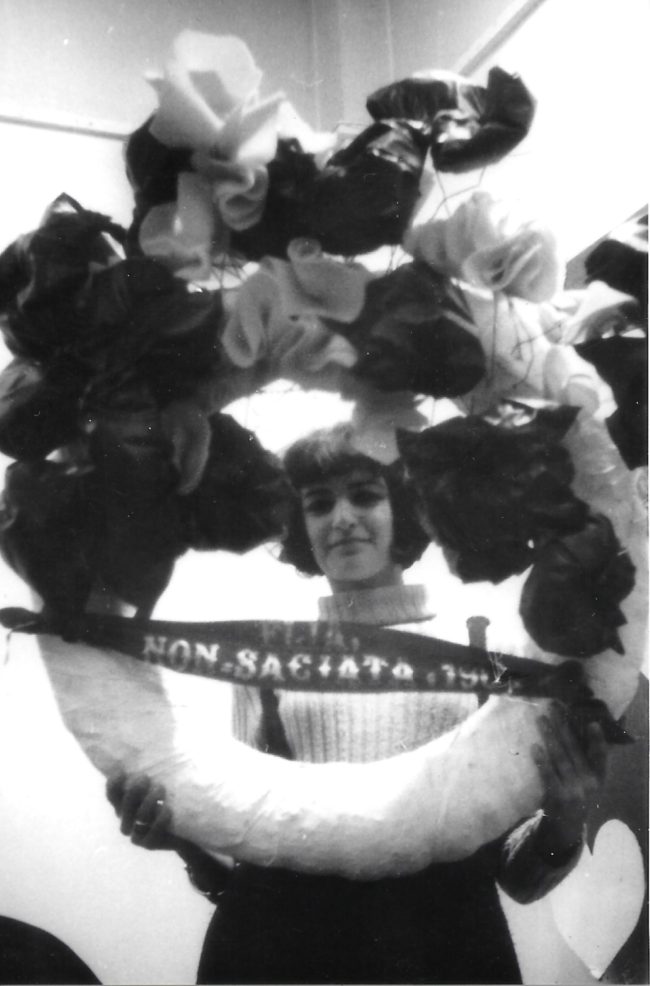

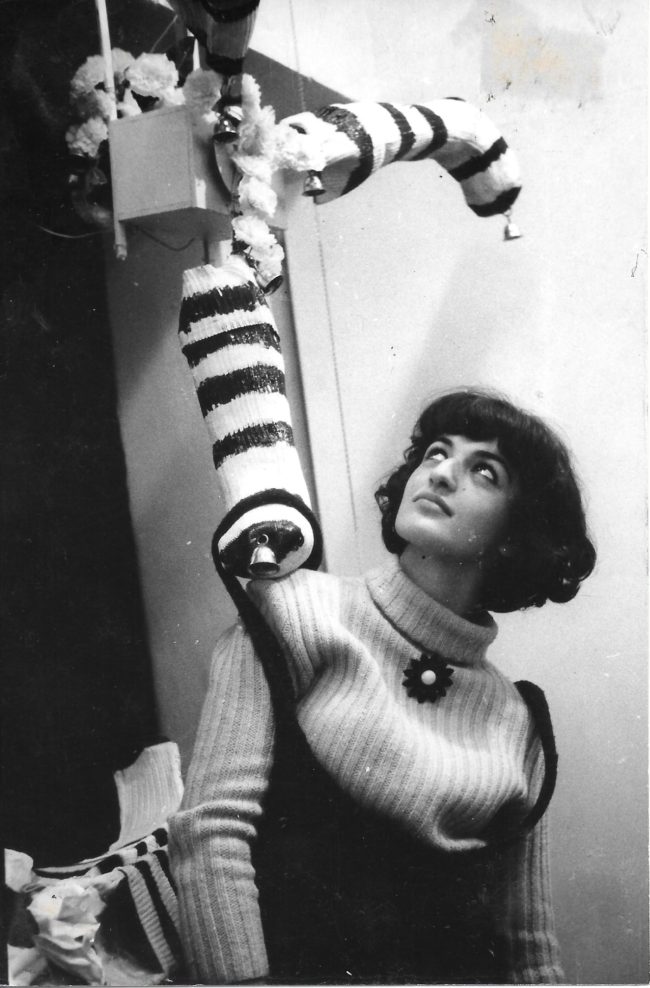

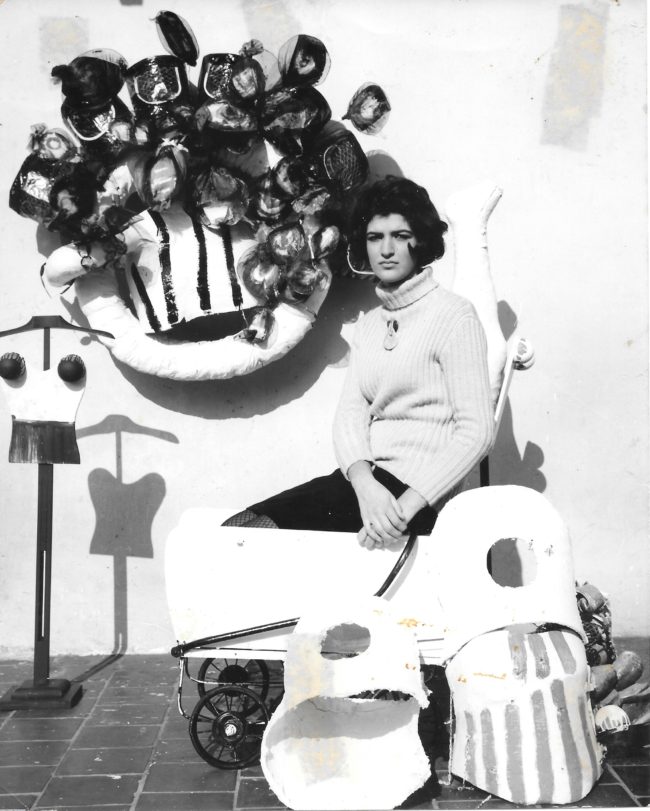



The first time I went with dad to the city of Montevideo in the year ’55, something happened in the neighborhood of that Hotel Central. A big accumulation of colorful energies intertwined forces that turned into mortuary crowns.
Visually they were a provocative and enigmatic demand since they weren’t natural flowers but almost flat plastic representations.
This confrontation with human ritual revealed to me a vocabulary that, over all definitions, gave me a sense of the fresh dramatic; I could immerse myself in a rudimentary world, where the wrappings, ribbons and golden letters allowed me individual dreams in fluid terms, a crucial connection of mystery and allegorical power.
When these crowns are installed, they immediately give the impression that something is happening in the neighborhood. Some dramatic episode of real life.
The fantasy becomes even more incredible, chaos and order in bizarre proportion.
Dalila Puzzovio, May 1998
La primera vez que fui con papá a la ciudad de Montevideo en el año ’55, algo ocurrió en la vecindad de ese Hotel Central. Una gran acumulación de coloridas energías entrelazaban fuerzas que se convertían en coronas mortuorias.
Visualmente eran una demanda provocadora y enigmática ya que no eran de flores naturales sino de representaciones de plástico casi planas.
Este enfrentamiento al ritual humano, me reveló un vocabulario que sobre todas las definiciones me entregaba un sentido de lo dramático fresco; podía sumergirme en un mundo rudimentario, donde las envolturas, las cintas y las letras doradas me permitieron sueños individuales en términos fluidos, una conexión crucial de misterio y poder alegórico.
Al instalarse estas coronas, inmediatamente dan la sensación de que algo está ocurriendo en la vecindad. Algún episodio dramático de la vida real.
La fantasía se hace aún más increíble, caos y orden en bizarra proporción.
Dalila Puzzovio, Mayo 1998
“While some build others destroy”, proposes a re-reading of the homonymous performance act, conceivedby Dalila Puzzovio, Pop Art key figure, for Claudia magazine, during the extension of Av. 9 de Julio in BuenosAires, in 1979. The performance stages the marriage of a couple accompanied by their witnesses and courtship, surrounded by a scenery of pomp, feast and presents, contrasted by a city in ruins, which is the ironic scene ofthe action. The artist finds in the editorial medium a space of expression which she explores between the years1978 and 2004, where she writes, produces and illustrates articles for various media: Claudia magazine in the Practiclaudia section; Life & Fitness (commercial chronicler); Vogue Argentina in the fashion section; the Magazine of the Publicist, in the cosmetics; and Cuisine & Vins, in the section dedicated to art and artists of her time, etc.
Through a compilation and rescue process of archival material, that includes the performance documentation,its registration (negatives copied for the first time), recovered backstage images, the original Claudia magazine-edition August #266, 1979- and the artists testimony; is how the gesture of the action is reactivated and a discourse revisited, so pertinent to the actual context in which we live.
This ephemeral body of work – due to its performance and editorial nature – manifests the cleverness and versatility of Puzzovio, who has explored through several edges of the artistic practice: such as performance and happenings, micro-events, fashion, design, artistic direction and production, media art, costumes, publishing, plastic arts and writing, among others; languages that she managed to combine masterfully, blurring their limits and showing a free and bold vision, irreverent, which is the essence of her artistic work and the effervescence of an era. This plasticity and experiences were in the words of the artist, “key moments of transformation.”
The exhibition proposal allows us to understand from a new perspective, the ideas, the diverse repertoire and the contributions Argentine avant-garde practices have bequeathed us, in the hand of one of the major Pop Art exponents. Those expressions that conformed the 60s and 70s vanguard, were not considered within the canons of representation typical of contemporaneity, but instead were conceived from an unprejudiced and spontaneous gesture which core was experimentation; and that we can today, with due distance, understand as a way of life (art/life) different from artistic-intellectual speculation; where playfulness, irreverence and the futuristic worldview(characteristic of the time) reigned as a subterfuge to war, dictatorship, and the difficulties of daily life. In thewords of the curator, “Because, if we think about it, all, absolutely all battles are won with bread, love and fantasy.”
“Mientras unos construyen otros destruyen”, propone una relectura del acto performático homónimo, concebido por Dalila Puzzovio para la revista Claudia, durante la ampliación de la Av. 9 de Julio, en 1979. La performanceescenifica el casamiento de una pareja acompañada por sus testigos y cortejo, rodeada de un decorado de pom- pa, festín y presentes, contrastado por una ciudad en ruinas, que es el escenario irónico de la acción. La artista encuentra en el medio editorial un espacio de expresión que explora entre los años 1978 a 2004, en donde escri- be, produce e ilustra artículos para diversos medios: la revista Claudia en la sección Practiclaudia; Life & Fitness (cronista comercial); Vogue Argentina en la sección de moda; la Revista del Publicista, en la sección de cosmética; y Cuisine & Vins, en la sección dedicada al arte y los artistas de la época, etc.
A través de un trabajo de recopilación y rescate del material de archivo que comprende la documentación de la performance, su registro (negativos nunca antes copiados), imágenes del backstage recuperadas, la misma revis- ta Claudia -edición #266 de Agosto de 1979- y el testimonio mismo de la artista; es que se reactiva el gesto de la acción y se revisita un discurso, tan pertinente a la actualidad y contexto en el que vivimos.
Este cuerpo de obra tan efímero -por su naturaleza performática y editorial- manifiesta el ingenio y la versatilidadde Puzzovio, que ha transitado por varias aristas de la práctica artística: como la performance y aconteceres, el microsuceso, la moda, el diseño, la dirección y producción artística, el arte de los medios, el vestuario, lo editorial, las artes plásticas y la escritura, entre otros; lenguajes que ha logrado conjugar de forma magistral, desdibujando sus límites y evidenciando una mirada libre y audaz, de carácter irreverente, que es la esencia de su quehacer artístico y la efervensencia de una época. Esta plasticidad y experiencias fueron en palabras de la artista, “mo- mentos claves de transformación”.
La propuesta de exhibición permite entender desde una nueva perspectiva, las ideas, el diverso repertorio y el aporte que las prácticas de la vanguardia argentina nos han legado, de la mano de una de las artistas claves del Pop Art o “Arte de las cosas”. Aquellas expresiones que conformaron la vanguardia de los 60 y 70, no se consi- deraban dentro de los canones de representación propios de la contemporaneidad, sino por el contrario eran concebidas desde un gesto desprejuiciado y espontáneo cuyo núcleo fue la experimentación, y que podemos hoy con la debida distancia entender como un modo de vida (arte/vida) distinto a la especulación artística-inte- lectual; donde lo lúdico, lo irrenverente y la cosmovisión futurística (característica de la época) reinaban comosubterfugio de la guerra, la dictadura, y las dificultades de la vida diaria. En palabras del curador, “Porque, si lopensamos bien, todas, absolutamente todas las batallas se ganan con pan, amor y fantasía”.